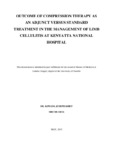| dc.contributor.author | Kibet, Joseph, K | |
| dc.date.accessioned | 2016-04-20T06:37:44Z | |
| dc.date.available | 2016-04-20T06:37:44Z | |
| dc.date.issued | 2015 | |
| dc.identifier.uri | http://hdl.handle.net/11295/94324 | |
| dc.description.abstract | Background:
Cellulitis is a common condition causing significant morbidity. Treatment is mainly by use of
antibiotics, limb elevation and analgesics.
Compression therapy is not used routinely in management of cellulitis but has been
extensively used in treatment of lymphoedema and venous ulcers.
Objective:
To determine the outcome of use of compression therapy as an adjunctin the treatment of
limb cellulitis compared to the use of standard treatment at Kenyatta National Hospital
(KNH).
Study design: A randomized controlled trial.
Setting: Accident and Emergency department, outpatient clinics and the wards at KNH.
Patients and methods:
Patients aged 12 years and above with cellulitis were recruited into the study. Patients were
randomly assigned to one group which was put on conventional treatment while in the other
half compression therapy was added. Randomization was done using a table of random
numbers.
Data was collected using questionnaires. Follow up for three days was done and thereafter
weekly for two weeks.
Data was entered into an access database. Differences of the patients in the two categories
were analyzed using T-test for continuous data and chi-squared test for categorical data using
SPSS version 16.
Results:
The results were presented using tables and charts. Compression therapy was associated with
greater reduction in pain compared to the conventional treatment. There was over 90%
reduction for compression therapy group versus 65% in standard treatment group on day
three. Tenderness resolved earlier on those on compression therapy and this was statistically
significant. (95.7% in the compression group versus 82.5% in the standard treatment group) Oedema was found to resolve better in those on compression therapy. However, this was not
statistically significant. (P values of 0.16 and 0.136 for days 2 and 3 respectively)
Conclusion:
The use of compression therapy is more effective in control of pain and tenderness in patients
with cellulitis of the limbs when compared to conventional treatment. | en_US |
| dc.language.iso | en | en_US |
| dc.publisher | University of Nairobi | en_US |
| dc.subject | Management of limb cellulitis | en_US |
| dc.title | Outcome of compression therapy as an adjunct versus standard treatment in the management of limb cellulitis at Kenyatta National Hospital | en_US |
| dc.type | Thesis | en_US |
| dc.description.department | a
Department of Psychiatry, University of Nairobi, ; bDepartment of Mental Health, School of Medicine,
Moi University, Eldoret, Kenya | |

